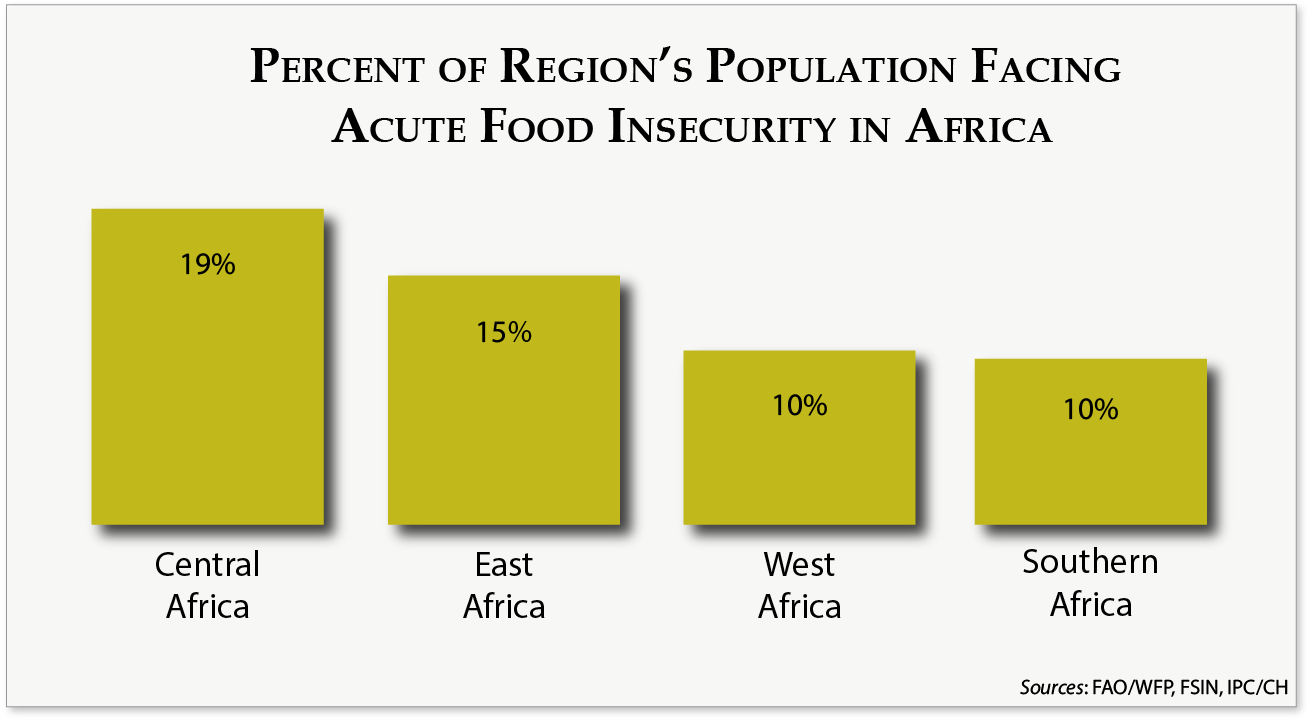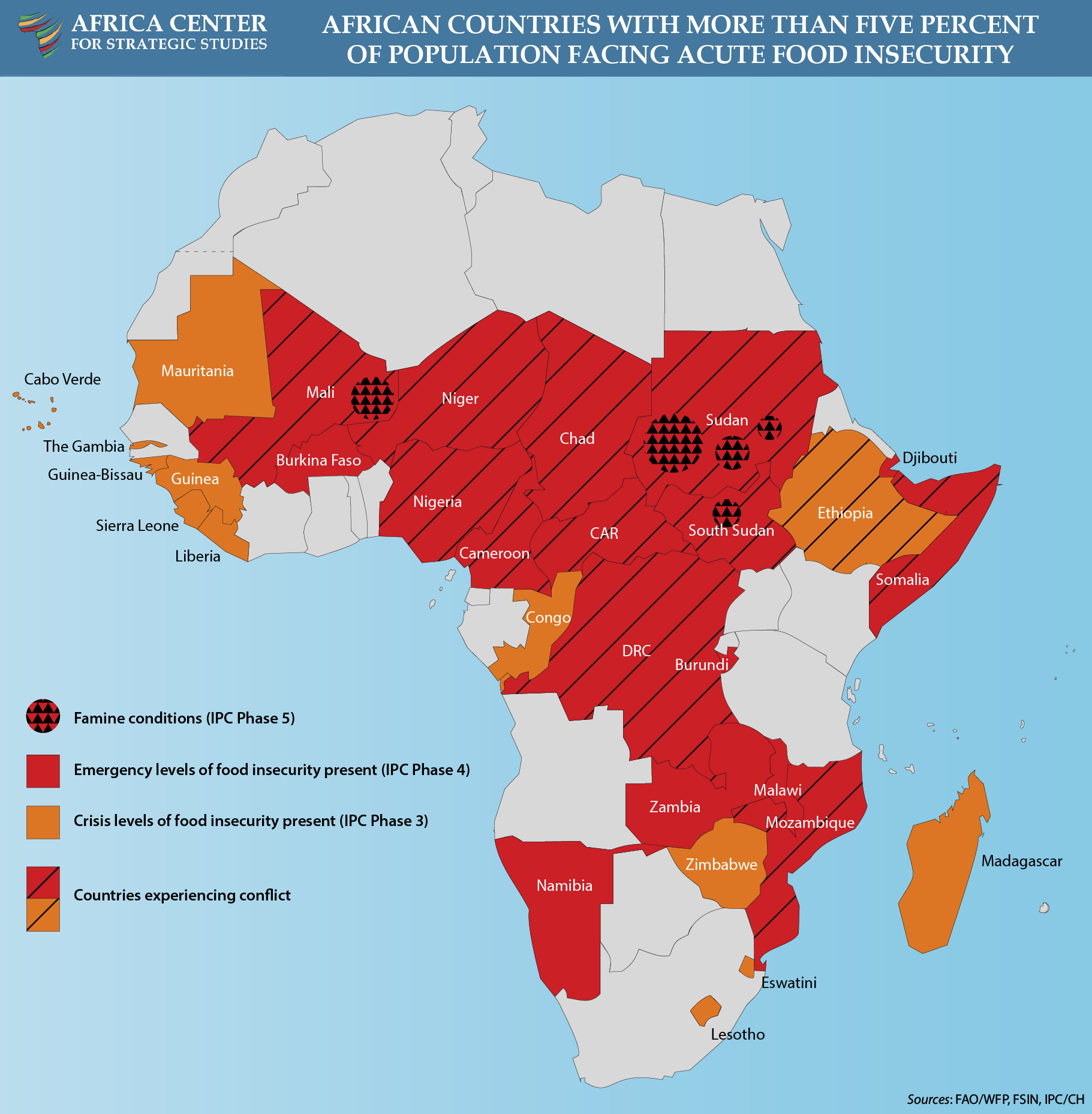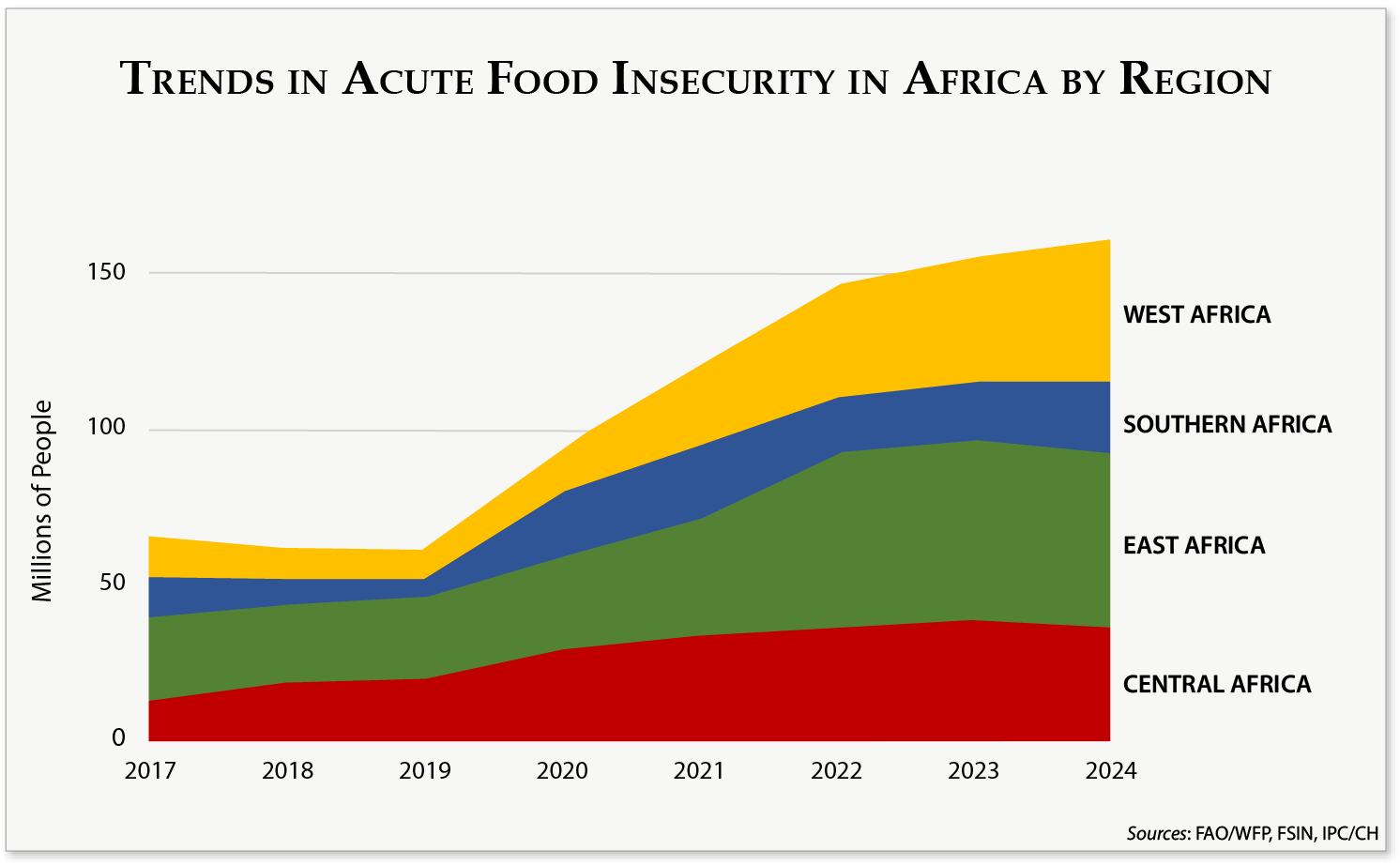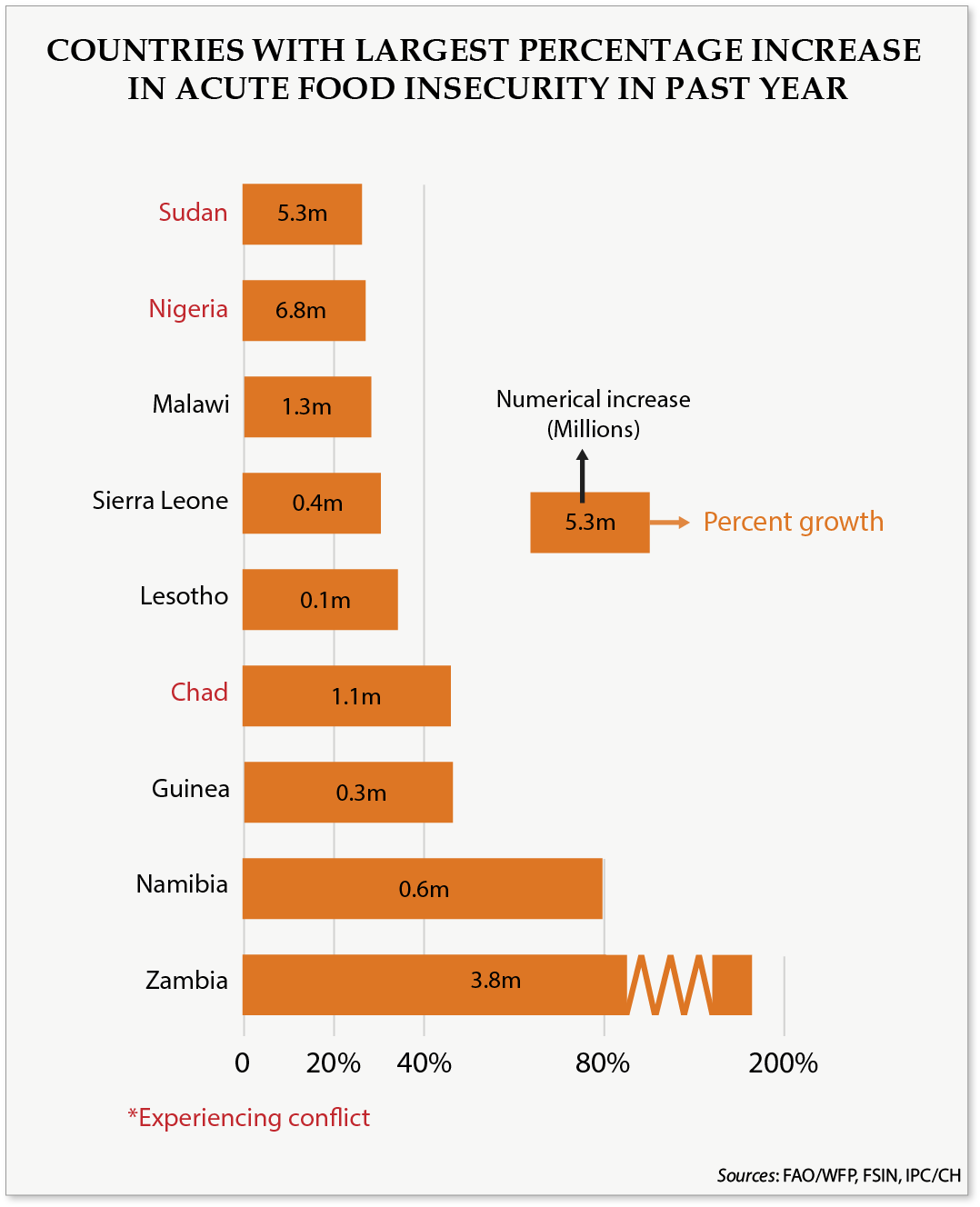Click here for a full-size map.
Highlights
- An estimated 163 million Africans are facing acute food insecurity—sustaining the record numbers of Africans experiencing food crisis. This total is nearly triple the number from 5 years ago, highlighting the rapid escalation in Africa’s food emergency.
Acute Food Insecurity
Acute food insecurity is when a person’s inability to consume adequate food puts their life or livelihood in immediate danger. This equates to a risk category of 3 or higher (crisis, emergency, and catastrophe) on the Integrated Food Security Phase Classification (IPC) scale of 1 to 5.
- Some 130 million (80 percent) of those facing acute food insecurity are in countries experiencing conflict, many of which have persisted for years and have eroded community and national coping mechanisms.
- 13 of the 16 African countries with the largest number of people experiencing acute food insecurity are in conflict. This pattern underscores that conflict continues to be the primary driver of acute food insecurity in Africa.
- Conflict-affected countries account for 18.6 million (94 percent) of those facing emergency levels (Phase 4), and 840,000 (100 percent) of those facing catastrophic (or Phase 5, famine) levels of food insecurity.
13 of the 16 African countries with the largest number of people experiencing acute food insecurity are in conflict. This pattern underscores that conflict continues to be the primary driver of acute food insecurity in Africa.
- Famine has been confirmed in the Darfur region of Sudan. Parts of South Sudan and Mali may also be experiencing famine conditions as well, though inaccessibility has limited data collection and reporting.
- This aggregate continental increase is mitigated somewhat by the winding down of the Tigray conflict in Ethiopia, which saw a decline in 3.9 million acutely food insecure individuals. Somalia and Uganda also saw dramatic drops in acute food insecurity (2.2-million- and 1.2-million-person declines, respectively) because of the breaking of the 2020-2023 East Africa drought.
- Nigeria, Sudan, and the Democratic Republic of the Congo are the three countries with the greatest number of acutely food insecure people—each with over 20 million individuals facing at least crisis levels of food insecurity. Collectively, these three countries comprise about half of all people on the continent facing acute food insecurity.
- Nigeria and Sudan also saw the largest aggregate increases in the number of people acutely food insecure this past year, adding 6.8 million and 5.3 million people, respectively.
- Four countries—South Sudan (64%), Sudan (53%), Namibia (48%), and the Central African Republic (44%)—have 40 percent or higher of their populations facing acute hunger.
Countries with More than 2 Million Facing IPC/CH Phase 3 and Above Food Insecurity
| Country | Conflict-Affected | IPC/CH Phase 3+ (millions) | IPC/CH Phase 4 (millions) | IPC/CH Phase 5 (millions) |
|---|---|---|---|---|
| Nigeria | √ | 31.7 | 1.0 | |
| Sudan | √ | 25.6 | 8.5 | 0.8 |
| DRC | √ | 23.4 | 2.9 | |
| Ethiopia* | √ | 15.8 | ||
| South Sudan | √ | 7.1 | 2.3 | 0.1 |
| Zambia | 5.8 | 0.2 | ||
| Malawi | 5.7 | 0.4 | ||
| Somalia | √ | 4.4 | 1.0 | |
| Niger | √ | 3.4 | 0.1 | |
| Chad | √ | 3.4 | 0.5 | |
| Mozambique | √ | 3.3 | 0.8 | |
| Zimbabwe* | 3.0 | |||
| Cameroon | √ | 2.8 | 0.1 | |
| Burkina Faso | √ | 2.7 | 0.4 | |
| CAR | √ | 2.5 | 0.5 | |
| Burundi | √ | 2.2 | 0.2 |
* IPC/CH five phases is not available for this methodology
Sources: FAO/WFP, FSIN, IPC/CH
- Africa’s food insecurity threat is simultaneously notable for its breadth. Some 23 out of 54 African countries have at least 10 percent of their populations facing acute food insecurity. This is more than double the number since 2019.

- The Central, East, West, and Southern African regions all have at least 10 percent of their populations experiencing acute food insecurity. Nineteen percent of the population in Central Africa is facing acute food insecurity, the greatest share of any region. Five of the seven countries in this region are in conflict.
- 11 countries saw at least a 20-percent increase in their acutely food insecure populations. These major shifts are felt sharply by the affected populations, even if these increases are not widely reported because of their relatively smaller populations.
- Though conflict remains the primary driver of acute food insecurity, lingering impacts from the pandemic on food production and trade, the disruption of global supply chains due to Russia’s invasion of Ukraine, threats to shipping from piracy and the Houthi attacks in the Red Sea/Western Indian Ocean, and weather shocks have all contributed to limiting availability and sharp rises in food prices.
- The El Niño climate pattern contributed to a devastating drought in Southern Africa this year. Meanwhile, in West and Central Africa, the transition to La Niña led to unusually heavy rainfall over the last few months. Since most of African agriculture is rain-dependent, these two extreme climate impacts have negatively affected tens of millions of people.
Following is a closer look at the African countries with the largest populations experiencing acute food insecurity.
Nigeria
An estimated 31.7 million Nigerians are facing crisis or higher food insecurity, including almost a million at Phase 4 (emergency) levels. This represents a 27-percent increase over last year and continues a steadily escalating trend since 2019.
Violence has displaced farmers and pastoralists while destroying crops and livestock. This violence is driven by militant Islamist groups such as Boko Haram and the Islamic State in West Africa (ISWA) in the North East, armed criminal groups in the North West, and farmer–herder conflicts in the Middle Belt. The disruption to supply chains and markets have caused food prices to spike throughout the country with overall inflation currently at 34 percent.
The government has deployed 10,000 “agro-rangers” in 19 states to address the insecurity on farms and rural areas. However, unusually heavy rains in West and Central Africa have further wreaked havoc on conflict-affected communities (including a dam break outside of Maiduguri, the capital of Borno State in the North East), farms, and markets across Nigeria’s food belt.
Sudan
Although historically the largest agricultural producer in Africa, Sudan is now experiencing the second highest aggregate levels of food insecurity on the continent. This food crisis is entirely self-inflicted due to the conflict that erupted in April 2023 between the rival Sudan Armed Forces and Rapid Support Forces militias. An estimated 25.6 million people (half of the country’s population) are experiencing acute food insecurity, including 8.5 million people experiencing emergency food insecurity and more than 756,000 are facing catastrophic or famine-level food crisis. The situation is especially critical for populations trapped in Darfur, Kordofan, Khartoum, and Al Jazirah States.
The UN has accused the warring parties of weaponizing access to food as international aid has been unable to reach the millions in need.
The warring parties have destroyed oil facilities, crucial ecosystems, the water supply, and wastewater infrastructure, condemning the country to long-term impediments to economic development. With the rainy season started, flooding has hit many parts of the country. Cases of cholera are surging. Sudan now has the largest displacement crisis in the world. The UN has accused the warring parties of weaponizing access to food as international aid has been unable to reach the millions in need.
Sudan’s conflict is also straining the coping mechanisms of its neighboring countries, causing increased stresses on food security for their citizens and the displaced they host (see Ethiopia, South Sudan, Chad, and the Central African Republic below).
Democratic Republic of the Congo
The key driver of food insecurity in the Democratic Republic of the Congo (DRC) is the multilayered conflict in the country’s eastern provinces. An estimated 23.4 million people (almost a quarter of the population) are experiencing acute food insecurity. This includes 2.9 million people facing emergency levels (Phase 4). With the expanding conflict in the east, where already more than 6.5 million internally displaced people are struggling to survive, these projections of acute food insecurity may be an underestimate.
As with other countries experiencing conflict, the displacement and threat of violence has prevented agriculturalists from tending to crops and livestock, reducing food supply and driving up prices of the food found in markets. More than 6 million people are displaced.
Ethiopia
Climate-related disasters (drought in some parts, flooding in others), the lingering displacement caused by the Tigray conflict, and ongoing clashes with ethnic militias in Amhara and Oromia regions have resulted in an estimated 15.8 million Ethiopians needing emergency food assistance.
South Sudan
This humanitarian crisis has been exacerbated by the rapid return of more than 630,000 South Sudanese citizens and 200,000 refugees fleeing Sudan’s conflict.
South Sudan faces persistently high levels of acute food insecurity due to ongoing conflict, natural disasters (severe flooding and dry spells), and the resultant soaring cost of food. This year, 7.1 million (over half of the population) are facing crisis levels of food insecurity, including 2.3 million facing emergency levels (Phase 4), and some 80,000 facing catastrophic levels (Phase 5).
This humanitarian crisis has been exacerbated by the rapid return of more than 630,000 South Sudanese citizens and some 200,000 refugees fleeing Sudan’s conflict.
The conflict in Sudan also ruptured the oil pipeline from South Sudan, negating the country’s primary source of foreign earnings.
Other Notable Food Insecurity Hotspots
Chad
Chad’s eastern provinces are laboring under the pressure of hosting almost 862,000 new Sudanese refugees, adding to the 400,000 who had fled to Chad in the early 2000s during the first Darfur crisis. Eastern Chad is heavily dependent on imports from Sudan for many basic commodities, including staple foods. Those imports have virtually stopped and the latest surge of displacement is expected to further deplete food stocks among host communities. Meanwhile, poverty and the remoteness of the displacement camps have hampered international food assistance.
Unusually heavy rains in 2024 have caused flooding that has destroyed livestock, crops, and 160,000 homes.
In the Lac region in the west of the country, insecurity from Boko Haram and ISWA, deteriorating livelihoods, local production shortfalls, and recurrent climate shocks (such as flooding and drought) have aggravated acute food insecurity. Unusually heavy rains in 2024 have caused flooding that has destroyed livestock, crops, and 160,000 homes.
As a result of these crises, almost 3.4 million Chadians (almost 20 percent of the population) are experiencing acute food insecurity, including 534,000 people facing emergency levels (Phase 4).
Burkina Faso
Burkina Faso remains a highly fragile environment where an increasingly isolated military junta is facing a militant Islamist insurgency that has besieged its capital as well as over 60 other municipalities. Burkina Faso currently has over 2.7 million people facing acute food insecurity, including 423,000 people facing emergency levels in the north and eastern provinces of the country where fighting is the strongest. Opacity surrounding the situation in Burkina Faso—the junta stopped reporting on its internal displacement crisis (last totaling 2.3 million people) in March of 2023—means that conditions in Burkina Faso could be much worse than is currently known.
Central African Republic
Conflict continues to be the key driver causing acute food insecurity among 2.5 million civilians in the Central African Republic (CAR). This includes 508,000 people at emergency levels. Armed conflict has been roiling CAR for 12 years and expectations are that conditions could to worsen in a country where half of the population relies on humanitarian assistance to survive.
Mali
Information blackouts instituted by the military junta in Mali mean the situation may be far worse.
Attacks by militant Islamists on populations in Timbuktu, Gao, and Ménaka are driving acute food insecurity in Mali, including catastrophe levels (Phase 5) in Ménaka. Almost 1.4 million people are projected to face acute food insecurity, including 121,000 people facing emergency levels (Phase 4) in Mopti, Gao, Tombouctou, and Kidal. Information blackouts instituted by the military junta in Mali mean the situation may be far worse. The situation is worsened by predatory assaults on communities in contested areas by the junta’s military forces and Russian paramilitary allies. Mali has also been impacted by severe flooding from La Niña-induced rains.
Somalia
Some 4.4 million Somalis (23 percent of the population) are still facing acute food insecurity, including almost a million at emergency levels (Phase 4) due to displacement and insecurity caused by the al Shabaab insurgency, particularly across the central and southcentral regions of the country contested by the militant group.
Non-Conflict-Related Food Insecurity
Southern Africa (Lesotho, Malawi, Mozambique, Namibia, Zambia, and Zimbabwe)
Six southern African countries experienced an El Niño-induced drought and heatwave that caused crop failures and livestock deaths causing all but Mozambique to declare national emergencies. The resulting shortfall in staple crops and the rising cost of food have left 5.8 million people in Zambia, 5.7 million in Malawi, 3.3 million in Mozambique, 3 million in Zimbabwe, 1.3 million in Namibia, and 400,000 in Lesotho facing acute levels of food insecurity. Zambia has been hit by a “perfect storm” of natural calamities including an outbreak of fall armyworms, locusts, and cassava brown streak disease.
Mozambique’s conflict in the northeastern part of the country is estimated to contribute to roughly 45 percent of the country’s acute food insecurity. Approximately 773,000 Mozambicans face emergency levels (Phase 4) of food insecurity.
More on: Food Security






